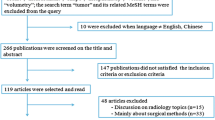Abstract
Background
It would be extremely useful if the location of the sentinel lymph node in breast cancer could be identified based on body surface landmarks. However, the identification of the sentinel node location by using surface landmarks in many reports is based on empirical methodologies.
Methods
We studied the distribution of the sentinel node location in 70 breast cancer patients based on the lateral line of the major pectoral muscle, the axillary skin fold that divides the trunk and the upper arm, and the nipple of the breast.
Results
The location of the sentinel node could be predicted using an ellipse with a semi-major axis of 2.8 cm and a semi-minor axis of 2.2 cm with a probability of 95% for a patient with the mean body size.
Conclusion
Our data demonstrate that the location of the sentinel nodes can be predicted within a narrow area based on body landmarks.


Similar content being viewed by others
References
Albertini JJ, Lyman GH, Cox C, Yeatman T, Balducci L, Ku N, et al. Lymphatic mapping and sentinel node biopsy in the patient with breast cancer. JAMA. 1996;276:1818–22.
Veronesi U, Paganelli G, Galimberti V, Viale G, Zurrida S, Bedoni M, et al. Sentinel-node biopsy to avoid axillary dissection in breast cancer with clinically negative lymph-nodes. Lancet. 1997;349:1864–7.
Veronesi U, Paganelli G, Viale G, Luini A, Zurrida S, Galimberti V, et al. A randomized comparison of sentinel-node biopsy with routine axillary dissection in breast cancer. N Engl J Med. 2003;349:546–53.
Bass SS, Cox CE, Ku NN, Berman C, Reintgen DS. The role of sentinel lymph node biopsy in breast cancer. J Am Coll Surg. 1999;189:183–94.
Kern KA. Sentinel lymph node mapping in breast cancer using subareolar injection of blue dye. J Am Coll Surg. 1999;189:539–45.
Reitsamer R, Peintinger F, Rettenbacher L, Prokop E, Sedlmayer F. Subareolar subcutaneous injection of blue dye versus peritumoral injection of technetium-labeled human albumin to identify sentinel lymph nodes in breast cancer patients. World J Surg. 2003;27:1291–4.
Koizumi M, Nomura E, Yamada Y, Takiguchi T, Makita M, Iwase T, et al. Radioguided sentinel node detection in breast cancer patients: comparison of 99 mTc phytate and 99 mTc rhenium colloid efficacy. Nucl Med Commun. 2004;25:1031–7.
Koizumi M, Nomura E, Yamada Y, Takiguchi T, Tanaka K, Yoshimoto M, et al. Sentinel node detection using 99 mTc-rhenium sulphide colloid in breast cancer patients: evaluation of 1 day and 2 day protocols, and a dose-finding study. Nucl Med Commun. 2003;24:663–70.
Anderson TA. An introduction of multivariate statistical analysis. 3rd ed. New Jersey: Wiley; 2003.
Motomura K, Egawa C, Komoike Y, Kataoka T, Nagumo S, Koyama H, et al. Sentinel node biopsy for breast cancer: technical aspects and controversies. Breast Cancer. 2007;14:25–30.
Rodier JF, Velten M, Wilt M, Martel P, Ferron G, Vaini-Elies V, et al. Prospective multicentric randomized study comparing periareolar and peritumoral injection of radiotracer and blue dye for the detection of sentinel lymph node in breast sparing procedures: FRANSENODE trial. J Clin Oncol. 2007;25:3664–9.
Borgstein PJ, Meijer S, Pijpers R. Intradermal blue dye to identify sentinel lymph-node in breast cancer. Lancet. 1997;349:1668–9.
Boolbol SK, Fey JV, Borgen PI, Heerdt AS, Montgomery LL, Paglia M, et al. Intradermal isotope injection: a highly accurate method of lymphatic mapping in breast carcinoma. Ann Surg Oncol. 2001;8:20–4.
Deurloo EE, Tanis PJ, Gilhuijs KG, Muller SH, Kroger R, Peterse JL, et al. Reduction in the number of sentinel lymph node procedures by preoperative ultrasonography of the axilla in breast cancer. Eur J Cancer. 2003;39:1068–73.
Krishnamurthy S, Sneige N, Bedi DG, Edieken BS, Fornage BD, Kuerer HM, et al. Role of ultrasound-guided fine-needle aspiration of indeterminate and suspicious axillary lymph nodes in the initial staging of breast carcinoma. Cancer. 2002;95:982–8.
Dixon JM, Dobie V, Chetty U. The importance of interpectoral nodes in breast cancer. Eur J Cancer. 1993;29A:334–6.
Shen J, Hunt KK, Mirza NQ, Krishnamurthy S, Singletary SE, Kuerer HM, et al. Intramammary lymph node metastases are an independent predictor of poor outcome in patients with breast carcinoma. Cancer. 2004;101:1330–7.
Author information
Authors and Affiliations
Corresponding author
About this article
Cite this article
Ueda, N., Tada, K., Miyata, S. et al. Identification of sentinel lymph node location based on body surface landmarks in early breast cancer patients. Breast Cancer 16, 219–222 (2009). https://doi.org/10.1007/s12282-008-0086-4
Received:
Accepted:
Published:
Issue Date:
DOI: https://doi.org/10.1007/s12282-008-0086-4




